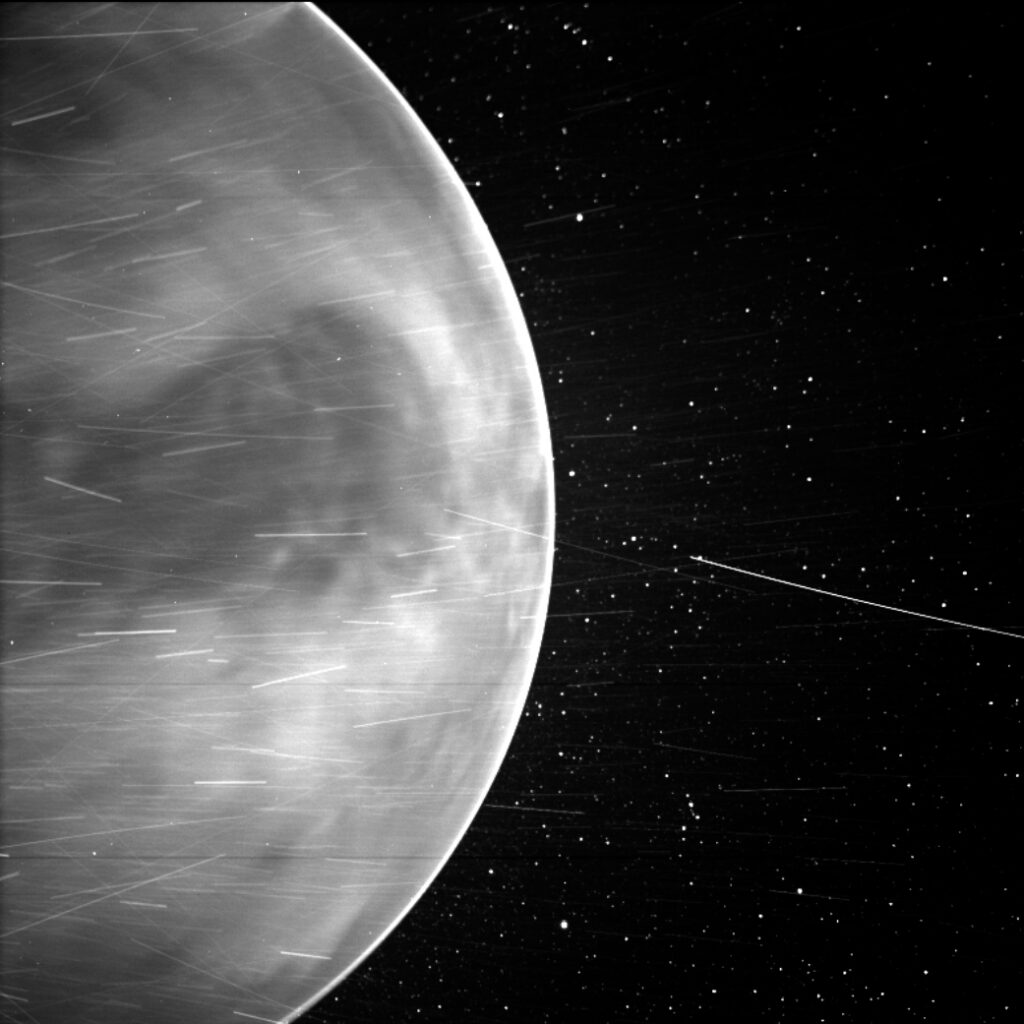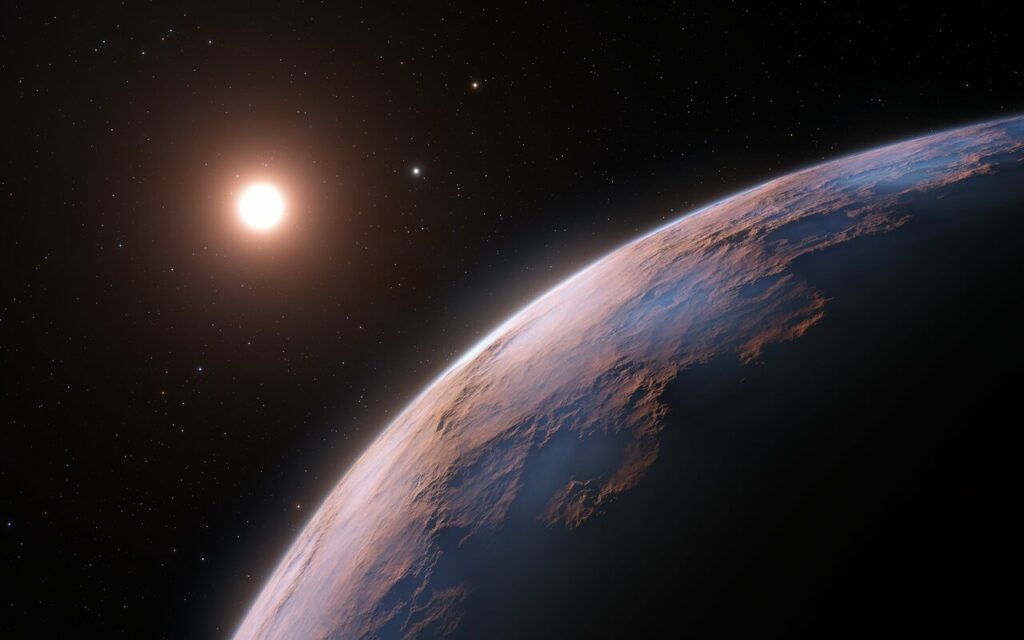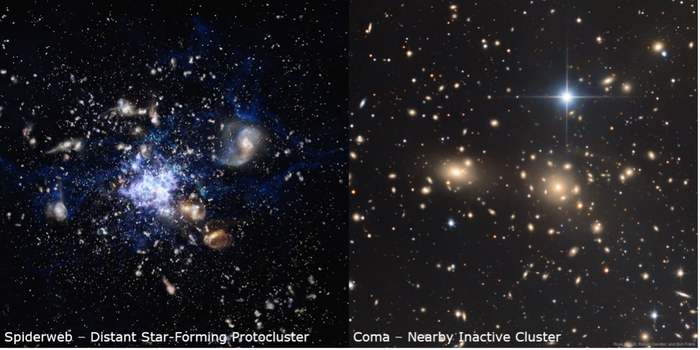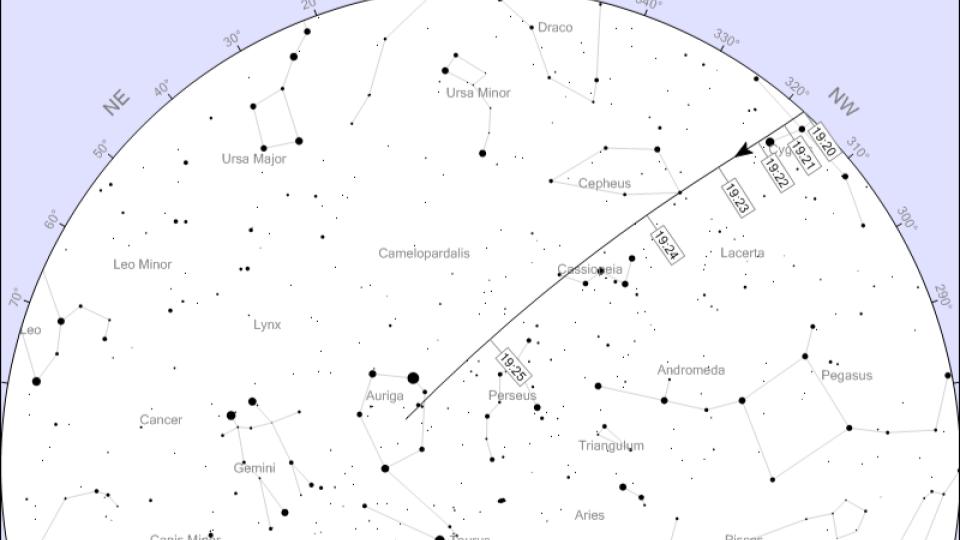Defying expectations, an ultramassive galaxy and many of its cluster companions had already formed most of their stars and become inactive only two billion years after the beginning of the universe. Plus, the nightside of Venus, a new exoplanet for Proxima Centauri, and What’s Up.
Podcast
Show Notes
Nighttime side of Venus revealed
- AGU press release
- NASA Goddard press release
- “Parker Solar Probe Imaging of the Night Side of Venus,” Brian E. Wood et al., 2022 February 9, Geophysical Research Letters
Star eat planet solar system
- University of Warwick press release
- “A white dwarf accreting planetary material determined from X-ray observations,” Tim Cunningham et al., 2022 February 9, Nature
New, nearby planet found
- ESO press release
- “A candidate short-period sub-Earth orbiting Proxima Centauri,” J. P. Faria et al., 2022 February 10, Astronomy & Astrophysics
Galaxies lived and died 2 billion years
- UC Riverside press release
- “Spectroscopic Confirmation of a Protocluster at z = 3.37 with a High Fraction of Quiescent Galaxies,” Ian McConachie et al., 2022 February 9, The Astrophysical Journal
What’s Up: Introduction to satellite observation
- Spot the Station (NASA)
Transcript
We’re pretty excited about today’s news. We have amazing images of Venus’s nightside, a white dwarf eating a planet, and a close-ish exoplanet.
Plus, strangely old galaxies found at the end of the universe, and Erik Madaus will join us to talk about how you can spot the International Space Station from your own backyard.
I am your host Dr. Pamela Gay.
And I am your host Beth Johnson.
And we’re here to put science in your brain.

Earlier this week, we interviewed Dr. Adam Szabo, Mission Scientist for the Parker Solar Probe. Now, we were talking to him because Parker is coming up on its next perihelion, or closest approach to the Sun, on February 25, but we apparently jumped the gun as they released new images of Venus just this week.
That’s right. Images of Venus.
To boost its speed and manage its trajectory, the Parker Solar Probe performs close flybys of Venus, and while there, takes as much data as possible. The latest images of Venus were taken with the Wide-Field Imager, also known as WISPR, and they show all of the nightside of Venus. These images are mostly in visible light but lean into the near-infrared, which is amazing in and of itself. Venus is difficult to image because of the heavy cloud cover and high temperatures. It’s especially difficult to see any detail in visible light, and that’s why the nightside was chosen for this observation.
The images actually captured details of the surface. There is a faint glow in which can be seen continental regions, plains, and plateaus. There’s even a halo of oxygen surrounding the planet. All of which add up so some amazing data we can use to study our so-called sister planet. As lead author Brian Wood explains: Venus is the third brightest thing in the sky, but until recently we have not had much information on what the surface looked like because our view of it is blocked by a thick atmosphere. Now, we finally are seeing the surface in visible wavelengths for the first time from space.
The Parker Solar Probe isn’t the first mission to visit Venus. NASA’s Magellan took images that helped create the first radar maps of the planet back in the 1990s. And then JAXA’s Akatsuki took infrared images while orbiting in 2016. And in the best of science results, the Parker Solar Probe images match up with Magellan’s radar maps. The press release explains: The WISPR images show features on the Venusian surface, such as the continental region Aphrodite Terra, the Tellus Regio plateau, and the Aino Planitia plains. Since higher altitude regions are about 85 degrees Fahrenheit cooler than lower areas, they show up as dark patches amidst the brighter lowlands. These features can also be seen in previous radar images, such as those taken by Magellan.
We’ll have links to NASA’s video and image comparisons in our show notes at DailySpace.org.
For those of you curious, the wavelengths captured were between 470 and 800 nanometers, and the visible range of light for humans is between 380 and 750 nanometers, so there was definitely some overlap. And since different materials have unique spectra at different wavelengths, all this hot material on the surface can be analyzed for its composition eventually as well.
We may get closer to understanding just how Venus’s planetary evolution diverged so greatly from Earth’s in the distant past, even before the three new Venus-dedicated missions are launched.
Parker Solar Probe is amazing, and it’s so much more than a mission to the Sun.

We talk a lot about planet formation around here. This is because, well, we’d like to know how we got here, and by looking at other forming solar systems we can make assumptions about how we got here and start to imagine someday answering things like how often these solar systems create life.
What we don’t talk about as much is how planets die.
This is partly because we just don’t get to see it happen very often. Planets die in a flash as they are either consumed into an expanding red giant or pulled into a stellar remnant. Catching this spark of death requires a bit of luck and knowing what it is you’re seeing when luck comes your way. Researchers from the University of Warwick studied white dwarf stars hoping for that luck as they looked for the tell-tale X-ray light from planetary debris vaporizing in the hot, dead stars’ atmosphere.
Stars like our Sun will one day stop fusing materials in their core, and when this occurs, they puff off their outer atmosphere while their core collapses down to something roughly the size of the Moon. Over time, these systems will cool, but they start out hot enough to vaporize anything that gets too close – including planets – and we see the chemical signatures of these former planets in white dwarf atmospheres.
And now, this team has seen one star, G29-38, actively consuming a former planet at a rate of more than two tons a second. As the story goes, the planet will first be torn apart by the gravity of the white dwarf, and then the former planet’s material spirals in, changing the star’s surface composition while flashing out in X-rays.
This work is published in Nature Communications with first author Tim Cunningham.
We don’t need to worry about our planet being consumed by the Sun for many billion years, but I guess it’s neat to know one possible way or world could end? Maybe?
I’d rather talk about planets waiting to be explored than being destroyed, so here is some planet discovery news.

Researchers using the Very Large Telescope in Chile have confirmed a new planet orbiting the nearby star Proxima Centauri. Just 4.2 light-years away, the star is a small red dwarf, and the planets orbiting it are also small. This new planet is roughly a quarter the size of Earth and orbits about every five days. This planet is in a part of the solar system that is likely too hot to be habitable by life as we know it, but that’s okay — a potentially habitable, Earth-sized world is already there, orbiting every eleven days. There is also another candidate planet with a weird distant orbit of every five years.
According to the lead author of this work, João Faria: The discovery shows that our closest stellar neighbor seems to be packed with interesting new worlds, within reach of further study and future exploration.
While we still don’t have the ability to get to this system in a human lifetime, we can dream of what future generations will be able to do. At least until our Sun destroys the Earth, but by then, hopefully, we’ll have sorted getting humans to Proxima Centauri. Maybe.
In somehow even less cheerful news, up next, we discuss, and here I quote the press release, the “surprisingly high fraction of dead galaxies found in an ancient galactic city.” The pictures are stunning. I just wish we had better language for some of the things we study.
Looking around our nearby universe, we see massive clusters of galaxies that have gravitationally come together and, through violent interactions, have stripped one another of the material needed to form stars. These systems are ancient, and we understand their appearance as the result of thirteen billion years of evolution. They are old. They are dead. This is how it should be.
The corollary of this was an expectation that when we look at the most distant clusters of galaxies, we’ll see smaller systems still forming and galaxies still rich in star formation.
But, expectation isn’t reality until observed.

And this brings us to one of the more amusing acronyms of recent episodes. The “Massive Ancient Galaxies At Z > 3 NEar-infrared,” or MAGAZ3NE, survey was designed to look at massive galaxies in the early universe using the Keck Observatory in Hawai’i. Working from the ground, this team looked back in time to see just what the early universe was doing. This literal case of looking back in time is possible because light takes time to travel, and like lag in a live broadcast, what we see is delayed by how long it takes the information to reach us. A bad YouTube delay might show me a rocket launch thirty seconds after it happened. With light, we know we see the Sun as it was eight minutes ago, we see Andromeda as it was when humans first started exploring the Earth, and as we look at things twelve billion light-years away, we see light from the first couple billion years of our universe.
According to the lead author of a new study in The Astrophysical Journal, Ian McConachie: In the early universe, all protoclusters discovered until now are full of vigorously star-forming galaxies.
Okay, expectations met, but I sense a “but” coming on.
Coauthor Gillian Wilson adds: We are seeing this protocluster [MAGAZ3NE J0959] as it appeared when the universe was less than 2 billion years old. It is as if you took a cluster like Coma, the nearest rich cluster of galaxies to Earth, and plopped it into the early universe.
Coma is nearby, old, and dead. This implies that this particular system, in the early universe, looks old and dead. That does not meet expectations.
MAGAZ3NE J0959 is a cluster with at least 38 member galaxies and contains an ultramassive galaxy in its core. Coauthor Benjamin Forrest nails the mystery of this system when he points out: Why this ultramassive galaxy and so many of its neighbors formed most of their stars and then became inactive when the universe was still so young, in contrast to other known protoclusters from the same time, is a big mystery. Why its galaxies are so unlike those in all the other known protoclusters, and so similar to those in Coma, is a complete mystery.
Finding these systems is still extremely difficult, and the fact that all other systems seen look young and vibrant tells us we may mostly understand what’s going on, but we need to figure out how this exception happens.
Unless of course, we learn these systems exist in large numbers, and we just haven’t been able to find them effectively because distant red galaxies are generally harder to see than distant star-bursting bluer galaxies.
And this is where we wait eagerly for the next generation of telescopes to tell us just how big a science mystery this system is. Are we seeing a random kind of formed fast, died young from a massive overdensity of material in the universe kind of thing? Or was the early universe weirder than we imagined?
This is your friendly reminder that scientists don’t know everything, but we really do want to, and this is why we science.
Want to learn how to check out some of the space-based observatories discussed in this show? Next up, Erik Maddaus brings us this week’s “What’s up” with pointers on how to see satellites.
What’s Up

This week in What’s Up is another lesson, but it’s not how to use your telescope. There are many things beyond the natural wonders of the universe to see in the night sky. There are some problems with mega-constellations, as we mentioned in our last show, but there is something neat about seeing a batch of newly launched Starlink satellites cross the sky one after another in short succession. This week is all about how to spot satellites.
The brightest satellite in Earth’s orbit is the International Space Station (ISS), with its thousands of square meters of solar panels reflecting sunlight every which way. If you have a good-sized telescope and can track it, you can see the fine detail of its structures, but that’s really challenging. Even binoculars can begin to resolve it. To the unaided eye, it’s just a dot like a star but one that moves much much quicker and is brighter than everything else in the sky, except the Moon.
Most of the satisfaction I get from watching satellite passes is not the visual interest, though the old Iridium flares were amazing, but by knowing that the dot does a useful task like gather data for weather forecasting or keeps a handful of people alive just outside the bottom of our gravity well.
In order to try visual satellite observing, however, you don’t need a lot of fancy equipment. All you really need is a watch to tell what time it is, a good idea of where the various compass points are, and pass predictions for where and when you’ll be observing.
There are many websites and apps that can help you know where and when to look for satellite passes. In my opinion, the best website is Heavens-Above, located at www.heavens-above.com. It has been around for a long time and is free to use. You can sign-up for a free account and tell it where you’ll be observing from, and it will provide you with a list of passes. Each satellite pass will include the name of the satellite, the time it will become visible, the maximum elevation above the horizon it will be (generally speaking, the higher the better), and the time it will disappear. It will also give you an indication of the direction it will travel, and you can even get a skymap depicting the pass.
Smartphone apps can range from free to quite expensive. Most of them will detect where you are and give you a list of the upcoming passes along with similar information to what you have on Heavens-Above. Some of them even have an augmented reality mode where you can point your phone at the sky and see an overlay of the pass. Another common feature is the ability to set an alarm for an upcoming pass.
As I mentioned, the International Space Station is the brightest man-made satellite that orbits the Earth, so it’s a great choice for your first attempt at visual satellite observation. In fact, NASA has set up a website dedicated to telling people how they can observe the ISS from where they live.
If you go to spotthestation.nasa.gov – and we’ll put that link in our show notes – you’ll find all sorts of information and resources that will help you watch it pass over. There’s a map that allows you to pick where you live and then see when the next passes will start, how long they will last, how high above the horizon the pass will be, and where it will appear and disappear. You can even sign up for email or text alerts that will let you know when passes that will be at least forty degrees above the horizon.
And if you’re curious as to where the ISS is right now, the Heavens-Above website also offers a 3D visualization showing the current attitude of the ISS and where it is above Earth.
Regardless of whether you use a website or an app to see a satellite pass, or you just want to look at the stars, be sure to go outside some clear evening and look up. Who knows what you’ll see!
This has been the Daily Space.
You can find more information on all our stories, including images, at DailySpace.org. As always, we’re here thanks to the donations of people like you. If you like our content, please consider joining our Patreon at Patreon.com/CosmoQuestX.
Credits
Written by Pamela Gay, Beth Johnson, and Erik Madaus
Hosted by Pamela Gay, Beth Johnson, and Erik Madaus
Audio and Video Editing by Ally Pelphrey
Content Editing by Beth Johnson
Intro and Outro music by Kevin MacLeod, https://incompetech.com/music/


 We record most shows live, on Twitch. Follow us today to get alerts when we go live.
We record most shows live, on Twitch. Follow us today to get alerts when we go live.